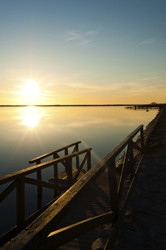Coastal lagoon conservation
The LAGOONS(opens in new window) (Integrated water resources and coastal zone management in European lagoons in the context of climate change) project developed scenarios of future trends and conditions in Europe's coastal lagoons. Four lagoons were selected as case studies, representing a wide and balanced geographical distribution and characteristics. They were the Vistula Lagoon in the Baltic Sea (Poland/Russia), Tylygulskyi Lagoon in the Black Sea (Ukraine), Ria de Aveiro Lagoon in the Atlantic Ocean (Portugal) and Mar Menor in the Mediterranean Sea (Spain). Researchers collated the current knowledge on the four case study lagoons and their river basins. Aspects such as climate, hydrology, water quality, water demand, land use, water and land-user conflicts, political structures, institutions and policies were all taken into consideration. This information was used to identify knowledge gaps and improve the participation of stakeholders, including the local population. Scientists also examined the effect of human activities and climate change in the future on the lagoons' hydro-biogeochemistry processes. They also studied the responses of key macrofauna indicators through ecotoxicological laboratory studies. Results from numerical modelling will be used to formulate quantitative and qualitative scenarios. Following the sequence of focus group, citizen jury and final workshop, a series of three stakeholder workshops were held in each of the case study areas. At these workshops, possible future scenarios were presented and discussed. This enabled scientific knowledge and the quantitative modelling results produced by LAGOONS to be combined with the local knowledge and views of the stakeholders. The project will provide a pan-European perspective and framework as well as overall strategy recommendations from the four case studies. It also set policy guidelines derived from the different analyses conducted by the project, and proposed management initiatives in the case study areas. LAGOONS will therefore contribute to the effective implementation of EU water-related policies. They include regional river basin management plans and national water use regulations and nature strategies. At the EU level these include the Water Framework Directive (WFD), the Marine Strategy Framework Directive (MSFD), the Nitrates Directive, the Common Agricultural Policy (CAP) and the Habitats Directive (Natura 2000). Project recommendations involved the sustainable use of water resources, best agricultural practices, and assessment of ecosystem services and their beneficiaries. Spatial planning of activities should take into account natural habitats and enable traditional activities and livelihoods to continue. In addition, research and training should be carried out on flood risk, adaptation to climate change and hydroecology.







